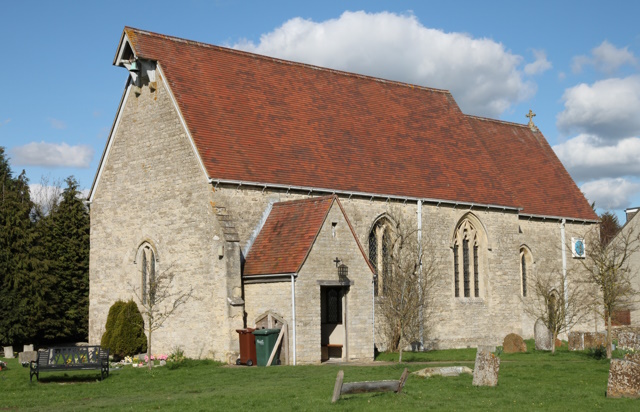


























St. Giles's Church, Wendlebury
St. Giles's Church in Wendlebury is an 18th-century building of stone, comprising a chancel, nave, and north transept. It replaces a medieval church of 13th-century date which was cruciform in shape with two transepts and a western tower. The medieval church had an altar dedicated to the Virgin and a rood-loft approached by a staircase from the north transept. The structure gave continual trouble, as the church was built on clay, and in 1639 the south transept was demolished as dangerous. By 1757 the whole building was considered to be beyond repair and a brief was issued authorizing the collection of money for a new church. In March 1761 the old church was demolished and by September the exterior of the new one was completed. The medieval tower was kept, as well as some early decorated windows and a doorway. Part of the old materials were also used. The foundations of the original church can still be traced at the east end, as the new church is 10 feet shorter than the old. The new church had a gallery at the back of the north transept which was designed for use as a choir and parochial library, while the ground floor of the tower was to be used as a porch and place for parish meetings. The south transept was reserved for landowners and their sons, with the servants in front. The wives and maid-servants and all children sat in the north transept; labourers and tradesmen sat on the south side of the nave and their wives on the north side. Plans were made in 1863 by G. E. Street for the partial rebuilding of what was then considered 'a modern and extremely unsightly church', but they did not materialize. In 1866 the rector repaired the chancel. The foundations of the new church were as troublesome as those of the old one and the cracked and leaning tower was reported unsafe; it was demolished between 1901 and 1902 together with the south transept. Neither has been rebuilt. At the same time the roof was renewed and new seating installed (architect J. O. Scott). There is a plain circular font and good wooden altar railings. When Rawlinson visited the original church in the early 18th century he found a stone in the chancel with a poem to John Birde (d. 1653), vicar of Bicester and rector of Wendlebury, and some armorial glass. The present church has inscriptions to several rectors: Matthew Bee (d. 1674), Stephen Cupper (d. 1676), John Bond (d. 1692/3), and Zachary Hussey (d. 1719); an urn-shaped marble plaque to Robert Welborne (d. 1764), a tablet to Thomas Edgerton (d. 1785), and a marble plaque by Bossom of Oxford to George Dupuis (d. 1839). There are also inscriptions to other members of the Bee family, and one to Mrs. Rachel Stevens, daughter of Zachary Hussey, who died at 94, beloved for her 'charity and benevolence'. Two coffins, one a rector's, were found when the south transept was demolished in 1639. In 1552 the church was poorly furnished with a chalice, two copes, and a vestment. There were three bells and a sanctus bell. The plate now includes a small Elizabethan chalice and paten cover and a huge bell-shaped chalice and paten of 1730, the gift of Thomas Turner, rector. Since the destruction of the tower the three bells, two of the 16th century and one of 1695, have been standing at the west end of the nave. The registers date from 1579. Robert Welborne, an 18th-century rector, made an alphabetical index to them with comments from 1579 to 1738. He notes that the earliest gravestone in the churchyard was dated 1667/8. Historical information about St. Giles's Church is provided by 'Parishes: Wendlebury', in A History of the County of Oxford: Volume 6, ed. Mary D Lobel (London, 1959), pp. 338-346. British History Online http://www.british-history.ac.uk/vch/oxon/vol6/pp338-346 [accessed 23 February 2023]. St. Giles's Church is a Grade II listed building. For more information about the listing see CHURCH OF ST GILES, Wendlebury - 1046559 | Historic England. For more information about St. Giles's Church see Parishes: Wendlebury | British History Online (british-history.ac.uk). |

